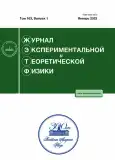Hysteresis of Magnetization and Electric Polarization in Magnetic Nanostructures with Dzyaloshinskii–Moriya Interaction
- Autores: Gareeva Z.V1,2, Shul'ga N.V1,2, Sharafullin I.F2, Doroshenko R.A1,3, Zvezdin A.K4,5
-
Afiliações:
- Institute of Physics of Molecules and Crystals, Ufa Scientific Center, Russian Academy Sciences
- Bashkir State University
- Prokhorov General Physics Institute of the Russian Academy of Sciences
- Lebedev Physical Institute, Russian Academy of Sciences
- Edição: Volume 163, Nº 1 (2023)
- Páginas: 66-71
- Seção: Articles
- URL: https://journals.rcsi.science/0044-4510/article/view/145476
- DOI: https://doi.org/10.31857/S004445102301008X
- EDN: https://elibrary.ru/NNOFSJ
- ID: 145476
Citar
Texto integral
Resumo
The influence of the Dzyaloshinskii–Moriya interaction (DMI) on the formation of polar structures in nanoscale magnetoelectric films has been studied. The sequence of micromagnetic structures of different topology at magnetization and remagnetization of a film of limited size in a magnetic field oriented along the normal to the film surface is investigated. It is shown that the formation of polar structures is related to the existence of magnetic structures. Specific features of polar states in dependence of the DMI type and the interface symmetry is analyzed.
Sobre autores
Z. Gareeva
Institute of Physics of Molecules and Crystals, Ufa Scientific Center, Russian Academy Sciences; Bashkir State University
Email: zukhragzv@yandex.ru
450075, Ufa, Russia; 450076, Ufa, Russia
N. Shul'ga
Institute of Physics of Molecules and Crystals, Ufa Scientific Center, Russian Academy Sciences; Bashkir State University
Email: shulga@anrb.ru
450075, Ufa, Russia; 450076, Ufa, Russia
I. Sharafullin
Bashkir State University
Email: zukhragzv@yandex.ru
450076, Ufa, Russia
R. Doroshenko
Institute of Physics of Molecules and Crystals, Ufa Scientific Center, Russian Academy Sciences;
Email: zukhragzv@yandex.ru
450075, Ufa, Russia
A. Zvezdin
Prokhorov General Physics Institute of the Russian Academy of Sciences; Lebedev Physical Institute, Russian Academy of Sciences
Autor responsável pela correspondência
Email: zukhragzv@yandex.ru
119991, Moscow, Russia; 119991, Moscow, Russia
Bibliografia
- S. Manipatruni, D. N. Nikonov, C. C. Lin, T. A. Gosavi, H. Liu, B. Prasad, Y. L. Huang, E. Bonturim, R. Ramesh and I. A. Young, Nature 565, 7737 (2019).
- G. Tian, W. Yang, D. Chen, G. Fan, Z. Hou, M. Alexe and X. Gao, Nat. Sci. Rev. 6, 684 (2019).
- M. Y. Liu, T. L Sun, X. L. Zhu, X. Q. Liu, H. Tian and X. M. Chen, J. Amer. Cer. Soc. 104, 6393 (2021).
- A. Fert, N. Reyren and V. Cros, Nat. Rev. Mater. 2, 7 (2017).
- L. Caretta, E. Rosenberg, F. Buttner, T. Fakhrul, P. Gargiani, M. Valvidares, Z. Chen, P. Reddy, D. A. Muller and C. Ross, Nat.commun. 11, 1 (2020).
- S. Rohart and A. Thiaville, Phys. Rev. B 88, 184422 (2013).
- C. O. Avci, E. Rosenberg, L. Caretta, F. Buttner, M. Mann, C. Marcus, D. Bono, C. A. Ross and G. Beach, Nat. Nanothech. 14, 561 (2019).
- D. H. Kim, M. Haruta, H. W. Ko, G. Go, H. J. Park, T. Nishimura, D. Y. Kim, T. Okuno and Y. Hirata, Nat. Mater. 18, 685 (2019).
- M. Heide, G. Bihlmayer, S. Blu¨gel, Phys. Rev. B 78, 140403 (2008).
- A. Soumyanarayanan, N. Reyren, A. Fert and C. Panagopoulos, Nature 539, 509 (2016).
- A. Samardak, A. Kolesnikov, M. Stebliy, L. Chebotkevich, A. Sadovnikov, S. Nikitov, A. Talapatra, J. Mohanty and A. Ognev, Appl. Phys. Lett. 112, 19 (2018).
- L. Wang, Q. Feng, Y. Kim, et al., Nat. Mater. 17, 1087 (2018).
- J. Lu, L. Si, Q. Zhang, C. Tian, et al., Adv. Mater. 33, 2102525 (2021).
- S. Muhlbauer, B. Binz, F. Jonietz, C. P eiderer, A. Rosch, A. Neubauer, R. Georgii and P. B¨onini, Science 323, 915 (2009).
- O. Cortes, M. Beg and V. Nehruji, New J. Phys. 20, 113015 (2018).
- I. Dzyaloshinsky, N. J. Phys. Chem. Sol. 4, 241 (1958).
- А. К. Звездин, А. П. Пятаков, УФН 179, 897 (2009).
- M. Mostovoy, Phys. Rev. Lett. 96, 067601 (2006).
- M. J. Donahue, US Department of Commerce, National Institute of Standards and Technology, (1999).
- Z. V. Gareeva, N. V. Shulga and R. A. Doroshenko, Europ. Phys. J. Plus 137, 454 (2022).
- K. L. Meltov and K. Y. Guslienko, J. Magn. Magn. Mater. 242, 1015 (2002).
Arquivos suplementares









